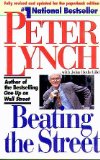In “Beating The Street” Peter Lynch tries to show ordinary investors how to pick stocks and get better returns on average than most professional investors. I would ordinarily have dismissed such a book outright, but when it comes from the former head of the Magellan Fund, which grew from $18 million in assets to $14 billion in assets in about 13 years under him, it merits a second look.
The approach described in the book is a rough mixture of value investing and identifying growth stocks, especially in businesses that you come across in your day to day life. For example, when you come across a chain of restaurants or stores that seem to be doing well and seem to be recommended by various folks, it pays to examine its finances and growth prospects and to then invest in it if it still looks good at the price it is trading. Such opportunities are likely to be present for small or boring companies that are not covered by any analysts. With decent diversification and periodic reviews of your portfolio, you should do pretty well for yourself - the author claims to have followed precisely such a process for his mutual fund with great results.
This investment approach seems particularly well-suited for ordinary folks who invest only occasionally, do not follow the markets or the economy very closely and are willing to be patient with their investments. The book is written in a very approachable manner and the language used is somewhat folksy. It is peppered with several so-called “Peter's Principles” throughout, some of which make sense and some of which are flippant. A collection of “25 Golden Rules” towards the end of the book seems much more useful and directly applicable.
Will such an approach work for you? If you do something other than investing for a living, can invest only part-time, but still want your savings to beat inflation and perhaps grow in value, you would want to believe in this approach. However, a bit of caution is in order here. The author had relatively vast amounts of money to invest compared to the ordinary investor and could directly talk to CEOs and CFOs in the companies he was interested in, some times even getting material information in advance of the general public. This might look like insider-trading, but it could reasonably be argued that this information was there for anyone who had bothered to ask. Some times companies themselves would approach such fund-houses with detailed presentations and executives ready to answer any queries in order to encourage them to invest. The author also regularly attended investor meets, AGMs, etc. All this is unlikely to be available for an ordinary investor with limited money and time.
Still it could be worthwhile to pursue such an approach since it seems fairly reasonable on the face of it. Anecdotally it does seem to work, despite what you might expect if the efficient-market hypothesis were really true. Since each investor's goals, appetite for risk, ability to weather turbulence in returns, etc. is different from others, you should try it with a portion of your funds to see if it really works for you. Even the author recommends that you keep the bulk of your money in professionally-managed mutual funds and index funds.
The bulk of the book is devoted to what are effectively case-studies from a wide range of industries showing how the author applied this approach. What makes the book particularly endearing is that the author is ready to show us his triumphs as well as his mistakes - missed opportunities, erroneous judgements, etc. - and how he recovered from such mistakes. The case-studies should provide enough information for you to apply this approach to your own investments.
With the benefit of hindsight, some of the author's comments are amusing. For example, he had great enthusiasm for mortgage-backed securities that saved Fannie Mae at the time, but which are now blamed for the financial crisi of 2008. He seemed to be quite skeptical of technology stocks. He seemed to think that copper-prices were bound to go up since telephone companies had to lay cables to reach most of their potential customers and the ridiculous alternative would be “to put a cellular phone in every pocket”! (The book was written around 1992.)
